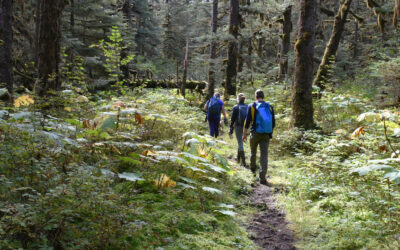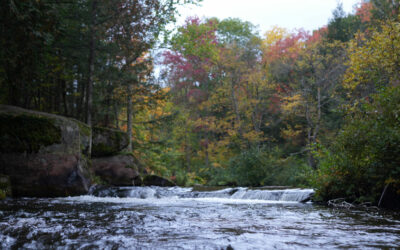A shrine in front of the sacred river in Osun Osogbo. Photo credit: Carsten Ten Brink
Exploring Wilderness in Yorùbá Culture: A Journey of Understanding
International Perspectives
December 2023 | Volume 29, Number 2
Recognizing the value of these traditional ecological knowledge practices, it is essential to integrate them into modern conservation approaches. By building upon and incorporating these strategies, managers of protected areas can enhance the effectiveness and sustainability of conservation efforts.
The Yorùbá are an ethnic group located in Nigeria with a rich cultural heritage that is expressed through various practices, customs, and traditions. These practices have influenced not only Nigerians but other African cultures and even the global African diaspora. This rich cultural heritage of the Yorùbá people is believed to be significant because it provides a means of transmitting cultural knowledge from one generation to the next. But there remain many gaps in knowledge about the contribution of the cultural practices of the Yorùbá people to biodiversity conservation. I explore traditional ecological knowledge to explain the agelong efforts and practices of the Yorùbá people toward biodiversity conservation. Examples of these practices and their efforts toward the conservation movement are presented. One is the tradition of forest conservation, where sacred groves are preserved as a symbol of cultural heritage. These sacred groves are seen as spiritual places, and the trees and other plant species found in these groves are protected by cultural taboos and beliefs. I explain how these practices preserve the Osun-Osogbo Sacred Grove, which is a UNESCO World Heritage Site and a living testimony to the Yorùbá culture’s contribution to biodiversity conservation. My conclusion is that while these practices have helped preserve sensitive parts of our environment up until now, there’s a need to build upon and integrate these practices into modern conservation best practice. A case is also made for developing the practice into the educational system, not as a historical piece but as a relevant and valuable management strategy.
Cultural Sites Hold Ecological Value for Conservation
In the United States, federally designated wilderness offers flora, fauna, and people refuge from ever-expanding cities and industrialization. But for many other societies around the world, nature is deeply rooted in culture and spirit. Trees hold sacred value in cultures such as India and Ghana, inspiring the preservation of biodiversity in sacred groves (Ortsin 2015). In some parts of Africa, Indigenous people visit shrines dedicated to deities in mountains, forests, rivers, hills, and lakes (Olupona 2006). In Latin America, mountains are revered as sacred sources of water and healing. The majestic Mount Fuji in Japan has become a symbol of the country’s pursuit of beauty and perfection (Bernbaum 1997).
Case studies from various regions exemplify the intricate interplay between nature and culture, shaping the perception, utilization, and management of these areas. For example, the Gikuyu people of Kenya, as well as the Meru, Luo, and certain Zulu clans in South Africa, consider the fig tree to be sacred. The Zulu clans attribute divination and fertility symbolism to the fig tree, leading them to offer sacrifices, perform rituals, and offer prayers in its proximity. Similarly, for the Gikuyu community, the fig tree embodies spirits, deities, and communal power. Consequently, cutting down or harming a fig tree is considered taboo among these communities, and it is strictly prohibited to use it as firewood. If a fig tree accidentally falls, rituals are conducted to appease the gods and safeguard the communities from their wrath (Mandillah and Ekosse 2018).
It is widely recognized that biodiversity conservation cannot be successful without involving the traditional communities residing in, not apart from, forested and other natural landscapes (Solomon et al. 2007; Berkes et al. 2000). Cultural sites, especially sacred sites maintained by Indigenous people, hold ecological uniqueness and importance for conservation at various scales (Salick et al. 2007). Indigenous communities around the world attribute religious significance to headlands, springs, trees, and forests, often incorporating ecological, conservation, and sustainable development strategies into their spiritual beliefs (Johnson 1992). Hence, numerous studies have highlighted the role of Indigenous knowledge and cultural beliefs in biodiversity conservation. These success stories emphasize the need for protected area managers to not only base their interpretation, management, and conservation efforts on scientific research and practice but also on deeply held spiritual, cultural, and aesthetic values (Bernbaum 2018).
Sacred groves are often small, forested ecosystems (Oyelowo et al. 2009) that have historically been protected by local communities as an integral part of traditional resource conservation systems around the world. These groves serve as refuges where endangered species of animals and plants can persist (Hughes 2006). Sacred groves consist of strands of trees or forest patches that local or Indigenous communities protect primarily due to their religious beliefs and rituals that have been passed down through generations (Meena and Singh 2012). They serve as havens for rare and endangered species and represent remnants of primary forests untouched by local communities, who believe that deities reside within these sacred trees or forests (Khumbongmayum et al. 2004).
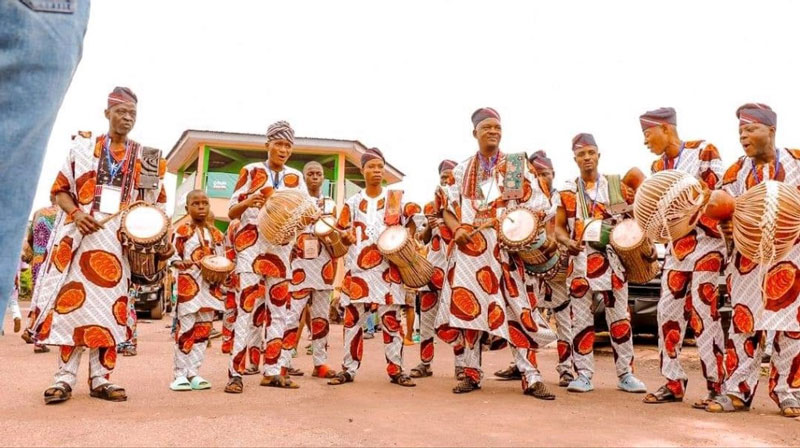
Figure 1 – Yoruba traditional drummer at the 2023 Osun Osogbo Festival and devotees of the Osun River goddess at the festival. Photo by Sikiru Obarayese.
This paper delves into the invaluable contribution of Yorùbá cultural practices in the preservation and subsequent recognition of the Osun-Osogbo Sacred Grove as a UNESCO World Heritage Site. While heritage sites and wilderness areas are typically distinct concepts, the Osun Osogbo Sacred Grove stands as a unique case where they intertwine. Unlike most heritage sites, which primarily focus on cultural, historical, or natural significance, the Osun Osogbo Sacred Grove embodies both cultural and biodiversity conservation. Despite significant visitation during the annual Osun Osogbo Festival, which celebrates the grove, the Yorùbá people have employed their agelong practices to ensure the preservation of this natural heritage. Their ancestral wisdom and sustainable resource management techniques have kept the grove and its resources from complete degradation (Oladipo et al. 2021).
This intimate relationship with the Osun Osogbo Sacred Grove highlights a profound connection between Indigenous communities and the wilderness. It serves as a testament to the mutual benefits and coexistence that can be achieved through cultural practices rooted in respect, knowledge, and harmony with nature. This exceptional case demonstrates that in this part of the world and for most Indigenous areas where cultural practices remain, Indigenous people benefit wilderness and conservation. Involving and integrating their traditional practices becomes essential for the sustainable management of the grove and its resources. Also, there exist some unscientific actions that might not be sustainable. I make a call for Indigenous traditional practices and knowledge systems to be receptive to modern management strategies for preserving what is left of the Osun Osogbo Sacred Grove.
The Yorùbá Culture Is Entwined with the Environment
The Yorùbá ethnic group, primarily located in southwestern Nigeria, encompasses both a people and a language known as Yorùbá. Due to historical factors such as the trans-Atlantic slave trade and commerce, the Yorùbá people and their language have spread to other West African countries and to the Americas, Brazil, and Cuba, among others (Mullen 2004).
The Yorùbá are one of the largest cultural groups in Africa, with approximately 40 million individuals worldwide. They have a rich history of living in advanced urban kingdoms for more than 1,500 years, developing a robust economy through farming, trading, and artistic production. Their artistic traditions, including woodcarving, sculpture, metalwork, textiles, and beadwork, are highly distinctive and renowned (Adejumo 2023).
The early history of the Yorùbá is surrounded by diverse myths, many of which revolve around Odùduwà, considered the quasi-mythical ancestor of the Yorùbá people. According to these myths, the various Yorùbá subgroups are believed to have descended from Odùduwà (Adekola 2021). The town of Ife holds particular importance in many of these mythological narratives. The Yorùbá culture encompasses distinct ways of life, evident in their dietary system, socioeconomy, political organization, music, religion, moral values, customs, traditions, and language (Adekola 2021). While the Yorùbá culture has experienced changes over time, certain practices have contributed to the conservation movement.
Hunting played a prominent role in Yorùbá society, as hunters were highly respected members of their communities. Initially, hunters used traps made from roots and fibers to catch animals, but later, iron implements were introduced for trapping larger game. However, certain animals were considered off-limits for hunting, and hunters were required to perform specific rituals if they accidentally killed these mysterious game animals (Adekola 2021).
Taboos exist among the Yorùbá, forbidding certain groups of people from consuming specific food items. For example, some individuals are prohibited from eating snails, twin bananas (Ogede Ibeji), and monkeys. These taboos extend beyond food and encompass the protection of forests as sacred spaces (Igbó àìwọ‐ or Igbó ẹbọra) to restrict access and prevent environmental destruction. The observation of these taboos serves to preserve the environment (Babalola 2011).
The Yorùbá have various deities such as “Oya” (wind/storm), “Ifá” (divination or fate), “Eleda” (destiny), “Orisha” or “Orisa Ibeji” (twin), “Osanyin” (medicines and healing), “Osun” (goddess of fertility, protector of children and mothers), and “Sango” (God of thunder) (Babalola 2011). These deities have designated places of worship, which can be located within towns or forests. When situated in forests, these shrines are protected. Nonadherents are forbidden from entering, except during open festivals that occur once a year, limiting human use of these areas.
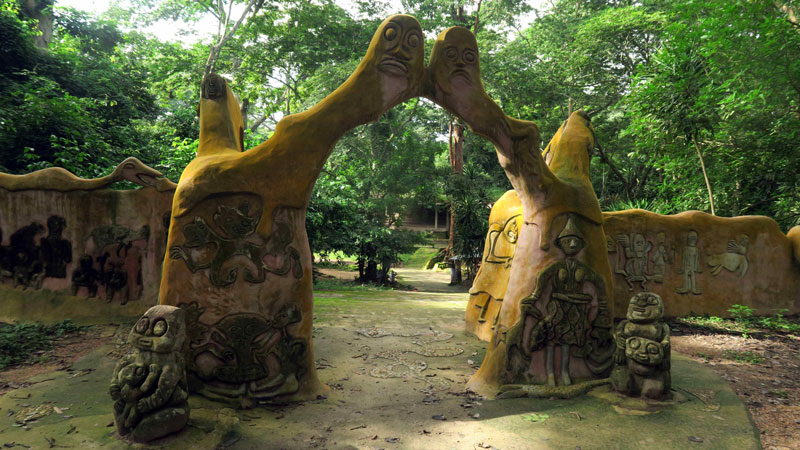
Figure 2 – The palace gate to the sacred grove in Osun Osogbo. Photo by Omoeko Media.
Another integral aspect of Yorùbá culture is the celebration of festivals. Festivals bring diverse people together at specific times of the year to commemorate important historical events, whether related to ancestral achievements, human-deified figures, or living individuals. These festivals serve as a reflection of individual or collective efforts, and they contribute to the preservation of cultural practices (Fálẹ‐yẹ 2021).
Some of these early cultural practices led to the designation of groves, natural areas that serve as abodes for a category of divinities. For instance, the myriad spirits that populate the world of the Yorùbá are associated with hills, mountains, rivers, rocks, caves, trees, brooks, lakes, and thick forests.
Osun Osogbo Sacred Grove Has Withstood the Test of Time
The Osun Osogbo Sacred Grove, located on the outskirts of Osogbo in southern Nigeria, is one such sacred grove and is considered one of the region’s last remaining primary high wilderness areas. It is recognized as the dwelling place of Osun, the goddess of fertility and one of the Yorùbá pantheons of gods. Within the grove’s landscape, meandering rivers are adorned with sanctuaries, shrines, sculptures, and artworks dedicated to Osun and other deities. This sacred grove, now seen as a symbol of Yorùbá identity, stands as one of the few remaining groves in Yorùbá culture, bearing witness to the historical practice of establishing sacred groves outside settlements (UNESCO 2005).
The Osun Osogbo Sacred Grove is a culturally evolved landscape that has withstood the test of time, leading to its designation as a World Heritage Site. It spans approximately 75 hectares and is characterized by rain-forest vegetation typical of West Africa, boasting more than 400 plant species, about 200 of them with medicinal properties, as well as more than 40 different tree species and critical wildlife, including mona and white-throated monkeys (Osaghale, Omisore, and Gbadegesin 2014). The dense wilderness area within the grove represents one of southern Nigeria’s last primary high biophysical concentration vestiges. Flowing through the wilderness is the river Osun, regarded as the spiritual abode of the river goddess. Forty shrines, sculptures, and art pieces dedicated to Osun and other Yorùbá deities are situated within the sanctuary. Many of these structures have been erected in the past 40 years. Additionally, the grove includes two palaces, five sacred sites, and nine worship points located along the riverbanks, each with designated priests and priestesses (UNESCO 2005). Initially declared a National Monument in 1965, the grove’s protected area was expanded in 1992 to encompass the entire 75 hectares. Recognizing its significance, the Osun Osogbo Sacred Grove was inscribed on the UNESCO World Heritage List on July 15, 2005 (Okonkwo and Eyisi 2018).
The community’s traditional responsibilities and cultural rites are carried out through the Ataoja (king) and his council, known as the Osogbo Cultural Heritage Council. Various traditional practices are employed to safeguard the site from threats, including traditional laws, myths, taboos, and customs that forbid activities such as fishing, hunting, poaching, tree felling, and farming (UNESCO 2005). Forest preservation within the Osun Osogbo Sacred Grove system is ensured through the implementation of taboos, rituals, dedication of the forest to deities, government regulations, and the presence of grove guards. Local communities, priests, and traditionalists play significant roles in conserving the grove, with rituals serving as a fundamental means by which Osun priests preserve the grove’s biological and cultural features.
The perception of wilderness among the Yorùbá people differs from the Western perspective. While the Western view often associates wilderness with uninhabited and untouched areas for recreational and preservation purposes, the Yorùbá people hold a distinct understanding. For them, wilderness is not only a designated space for communal enjoyment and biocultural conservation but also an ancestral abode. This belief is evident in the presence of shrines within certain wilderness areas, symbolizing a connection between the Yorùbá people, their ancestors, and the wilderness. In addition, wilderness areas have traditionally served as important sites for rites of passage and the preparation of younger generations, particularly young males, for their future roles. During these formative experiences, young males would join older men on extended hunting expeditions that could last for days or even weeks. These expeditions served as opportunities to impart valuable skills, such as strength, resilience, and the ability to provide for oneself and the community. The wilder- ness became a classroom where knowledge was passed down through generations, ensuring the continuity of critical cultural practices.

Figure 3 – The Asipa Ode – Ataoja of Osogbo Land at the 2023 Osun Osogbo Festival. Photo by Yakubu Atanda.
To preserve the significance of these areas, specific practices and customs were established. These practices included rituals, taboos, and guidelines that regulated human activities within the wilderness. Such measures were put in place to maintain a harmonious relationship between the Yorùbá people and the wilderness, respecting the spiritual and cultural dimensions associated with these spaces.
Traditional Ecological Knowledge Deeply Rooted in Local Culture
Wilderness is not a separate entity; it is a part of the larger interconnected mosaic that interacts with and enhances other elements. Human use is not excluded from wilderness; in fact, wilderness is a concept created by humans and a form of human use. However, for wilderness to fulfill its purpose, it must maintain its integrity, which requires excluding certain types of human activities (Hughes 2006). Traditional knowledge systems and practices embedded in traditional cultures have become the tools for ensuring that wilderness remains preserved, as Rao (1996) suggests. Therefore, the survival and preservation of the Osun Osogbo sacred grove in its pristine state is a testament to the Yorùbá people’s traditional ecological knowledge and their appreciation for the wilderness that includes them and their cultural values and worldviews.
In the words of Berkes (1999), Traditional Ecological Knowledge (TEK) encompasses a growing reservoir of knowledge, customs, and convictions that develop through adaptive processes and are handed down from one generation to another. Ugandan scholar Dani Waded Nabudere (2001, p. 140) highlights that TEK is deeply rooted in the customs, institutions, and rituals of communities, as well as in practices such as prophecies and divinations.
TEK encompasses the understanding of the relationships between living beings, including humans, and their environment. Studies have documented how local ethnic groups have developed close interrelationships with local animals, plants, and forests, forming distinct Indigenous knowledge systems and traditional cultural beliefs (Babalola 2011). This is why Tamale (2020) emphasizes the need for TEK, because it fosters self-reinforcing institutions that operate autonomously, without the need for external regulation or the imposition of authority.
For the Yorùbá people, traditional ecological knowledge is conveyed through poetry, proverbs, tales, taboos, festivals, and superstitions, serving as effective means of passing down knowledge across generations. Some of these cultural tools have contributed to wilderness preservation in some areas of Yorùbá land. Harnessing these traditional taboos could contribute to achieving global sustainable development goals (Adejumo 2023).
While it is challenging to draw clear boundaries, traditional ecological knowledge generally differs from Western scientific ecological knowledge in several ways. Traditional ecological knowledge is deeply rooted in local culture, and management practices are adapted to the specific area. The resource users themselves act as “managers” and identify themselves as members of a local community rather than as individual scientists or government officials accountable to external authorities. Traditional systems often have a solid moral and ethical framework, with no distinction between nature and culture. In many traditional cultures, nature is considered sacred (Shepard 1973).
However, it is essential to acknowledge that tradition is not inherently virtuous. Some traditional practices and belief systems may not be adaptive or may lack a conservation ethic despite detailed environmental knowledge (Callicott 1994). There have also been instances of misap- plications of Indigenous knowledge leading to problems. Nevertheless, traditional ecological knowledge has proven to be applicable to wilderness preservation. In fact, it holds great promise for providing valuable insights and applications if it is used in the appropriate context.
Traditional Wisdom with Scientific Advancements Can Address Challenges
Cultural traditions across various communities have developed unique and effective strategies for conserving wilderness areas. These strategies are grounded in a deep understanding of the local environment and what it means to them as a people. This is why certain practices have proven successful in ensuring the long-term survival of key species, protecting habitats, and maintaining the overall health of ecosystems. They encompass diverse practices, such as sustainable resource management, habitat preservation, regulated hunting and fishing techniques, the establishment of sacred groves, and the enforcement of cultural norms and taboos that limit harmful human activities.
Recognizing the value of these traditional ecological knowledge practices, it is essential to integrate them into modern conservation approaches. By building upon and incorporating these strategies, managers of protected areas can enhance the effectiveness and sustainability of conservation efforts. Traditional knowledge offers valuable insights and approaches that complement scientific understanding, creating a more comprehensive and context-specific approach to wilderness conservation.
In addition, it is crucial to incorporate these traditional ecological knowledge practices into the educational system. By doing so, we can ensure that future generations know these conservation strategies and understand their relevance and significance in contemporary conservation efforts. By integrating traditional knowledge into curricula and educational programs, we empower individuals with the traditional understanding to actively participate in conservation and become responsible stewards of their environments.
This can foster a more inclusive and holistic approach to biodiversity conservation and allow drawing from the wisdom and experiences of different cultures, combining them with modern scientific advancements. The result is a more effective and culturally sensitive approach to conserving biodiversity, preserving cultural heritage, and securing a sustainable future for both ecosystems and communities.
Also, it is essential to acknowledge that specific unscientific actions may pose threats to the sustainability of a wilderness area such as the Osun Osogbo Grove. For instance, washing done during the festival right on the riverbank of the Osun Osogbo Grove has continued to increase the toxins in the river. This action is harmful to the aquatic species. However, with modern practices, this can be corrected. In fact, with the strengthening of the cord between modern and traditional practices, the grove can be better preserved. For instance, the use of dispersal and zoning techniques as well as monitoring equipment, are crucial for preserving and safeguarding the grove’s remaining natural and cultural treasures.
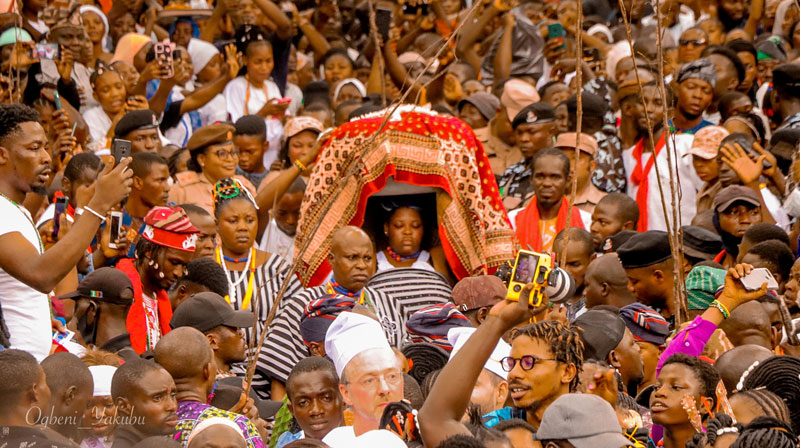
Figure 4 – The Arugba (Sacred Calabash carrier) during the procession to the sacred river. Photo by Sikiru Obarayes.
While Indigenous traditional practices have played a significant role in wilderness conserving the grove over the centuries, embracing modern management strategies can provide additional tools and insights for effective preservation. This can include adopting sustainable resource management techniques, zoning, reservation techniques, implementing monitoring and surveillance systems, and engaging in collaborative research efforts with scientists and conservation experts.
About the Author
EZEKIEL ADESAWE is a master’s student in the Department of Parks, Recreation, and Tourism Management at Clemson University. His research interests are outdoor recreation, youth development, wildlife, and conservation management; email:eadesawe@gmail.com
References
Adekola, K. 2021. Yorùbá traditions in the midst of foreign influences, a critical evaluation. Yorùbá Studies Review 5(1.2): 1–13. https://doi.org/10.32473/ysr.v5i1.2.130110.
Babalola, F. D. 2011. Roles of and threats to Yorùbá traditional beliefs in wilderness conservation in southwest Nigeria. USDA Forest Service Proceedings RMRS.
Berkes, F. 1999. Sacred Ecology: Traditional Ecological Knowledge and Resource Management. Taylor & Francis.
Berkes, F., J. Colding, and C. Folke. 2000. Rediscovery of traditional ecological knowledge as adaptive management. Ecological Applications 10(5): 1251–1262. https://doi.org/10.1890/1051-0761(2000)010[1251:roteka]2.0.co;2.
Bernbaum, E. 1997. Sacred Mountains of the World. Berkeley and Los Angeles: University of California Press.
Bernbaum, E. 2018. The cultural and spiritual significance of nature. In Cultural and Spiritual Significance of Nature in Protected Areas (pp. 133–146). https://doi.org/10.4324/9781315108186-9.
Callicott, J. B. 1994. Earth’s Insights: A Survey of Ecological Ethics from the Mediterranean Basin to the Australian Out- back. Berkeley: University of California Press.
Fálẹ‐yẹ, A. A. 2021. The structural changing phases of ifẹ‐ festivals and tradition towards economic boost and cultural tourism. Yorùbá Studies Review 5(1.2): 1–18. https://doi.org/10.32473/ysr.v5i1.2.130111.
Hughes, J. D. 2006. The mosaic of culture and nature: Organization of space in an inhabited cosmos. Nature and Culture 1(1): 1–9. https://doi.org/10.3167/155860706780272015.
Johnson, M. 1992. Lore: Capturing Traditional Environmental Knowledge. Ottawa, Ontario: Dene Cultural Institute, International Development Research Center.
Khumbongmayum, A. D., M. L. Khan, and R. S. Tripathi. 2004. Sacred groves of Manipur – ideal centres for biodiver- sity conservation. Current Science 87(4): 430–433.
Mandillah, K. L., and G. I. Ekosse. 2018. African totems: Cultural heritage for sustainable environmental conservation. Conservation Science in Cultural Heritage 18(1): 201–218. https://doi.org/10.6092/issn.1973-9494/9235.
Meena, D., and A. Singh. 2012. Oran of Rohida: An endangered tree species of Rajasthan. Current Science 103(12): 1389.
Mullen, N. 2004. Yorùbá Art and Culture. Phoebe A. Hearst Museum of Anthropology, University of California, Berke- ley.
Nabudere, D. W. 2001. From Agriculture to Agricology: Towards a Global Circular Economy. Johannesburg, SA: Real African Publishers.
Okonkwo, E., and A. Eyisi. 2018. Pilgrimage circuit of Osun Osogbo Sacred Grove and Shrine, Osun State, Nigeria. Journal of Tourism and Heritage Studies 13–28. https://doi.org/10.33281/jths20129.2017.2.2.
Oladipo, O., G. D. Osanyinleye, and A. Lawal. 2021. Assessment of the conservation values of Osun Osogbo Sacred Grove, Osun State, Nigeria. Tanzania Journal of Forestry and Nature Conservation 90(2).
Olupona, J. K. 2006. Religion and Ecology in African Culture and Society. Oxford Handbooks Online. https://doi. org/10.1093/oxfordhb/9780195178722.003.0012.
Ortsin, G. 2015. Ecological and socio-cultural resilience in managing traditional sacred landscapes in the coastal savannah ecosystem of Ghana. In Cultural Landscapes: Preservation Challenges in the 21st Century, ed. K. Taylor, A. St Clair, and N. Mitchell. Abingdon, UK: Routledge.
Osaghale, G., E. Omisore, and J. Gbadegesin. 2014. Exploratory survey on the maintenance of Osun Osogbo Grove, Nigeria. African Journal of Hospitality, Tourism and Leisure 3(2): 1–22.
Oyelowo, O., C. Adebagbo, O. Akinyemi, and Y. Osinubi. 2009. Traditional African knowledge in biodiversity conserva- tion. Journal of Agriculture, Forestry and the Social Sciences 6(1). https://doi.org/10.4314/joafss.v6i1.48616
Rao, R. R. 1996. Traditional knowledge and sustainable development: Key role of ethnobiologist. Ethnobotany 8: 14–24.
Salick, J., A. Amend, and D. Anderson. 2007. Tibetan sacred sites conserve old growth trees and cover in the eastern Himalayas. Biodiversity and Conservation 16: 693–706.
Shepard, P. 1973. The Tender Carnivore and the Sacred Game. New York: Scribner’s.
Solomon, T. B., H. A. Snyman, and G. N. Smit. 2007. Cattle-rangeland management practices and perceptions of pastoralists towards rangeland degradation in the Borana Zone of southern Ethiopia. Journal of Environmental Management 82(4): 481–494. https://doi.org/10.1016/j.jenvman.2006.01.008.
Tamale, S. 2020. Decolonization and Afro-feminism. Ottawa, Ontario: Daraja Press.
UNESCO World Heritage Convention. 2005, December 23. Osun-Osogbo Sacred Grove. World Heritage Convention. https://whc.unesco.org/en/list/1118/.
Read Next
Reflections on Wilderness 60 Years after the Civil Rights and Wilderness Acts
America’s dominant narrative of the origin of a beloved wilder- ness often centers Aldo Leopold in a heroic fight at the turn of the century against rapid industrialization that occurred at the expense of nature.
Removing the Wilderness Illusion: Emerging Professionals Explore Diversity, Equity, Inclusion, and Accessibility in Wilderness
From the eyes of four emerging professionals in land management come four different wilderness stories.
Medicine Fish Is Leading the Way to Heal, Build, and Inspire Menominee Youth through the Wild and Scenic Wolf River: An interview with Bryant Waupoose Jr., Founder of Medicine Fish
From a bird’s eye view, the Menominee Reservation is a forested oasis in sharp relief from neighboring landscapes of dairy farms spanning northeastern Wisconsin.


